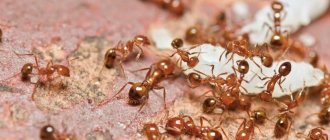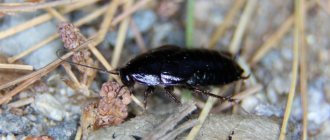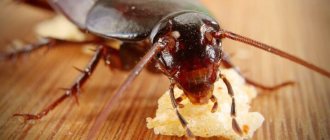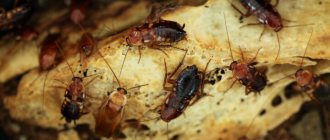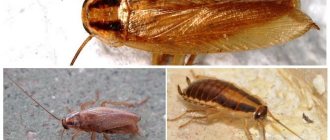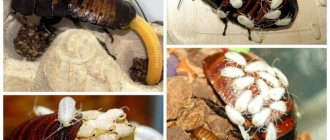Class Insects (Insecta)
Class Insects (Insecta).
Structural features, digestion, respiratory and excretory systems, sensory organs and representatives The most numerous class among the animal kingdom. There are over 1 million species (more than the species of plants and other animals combined). They live mainly on land, in the soil, and fly in the air. Some species have adapted to life in water, a parasitic lifestyle. Sizes range from a few millimeters to 25 cm (the wingspan of some species of tropical butterflies). The lifespan of adult insects is short (approximately several months). At the same time, some species can live for several years (female ants and termites - up to 20 years). The branch of zoology that studies insects is called entomology (from the Greek entomon - insect and logos - science). Possible ancestors of insects are centipedes.
The cuticle of insects is covered with a thin layer of fat-like substance that prevents the body from losing moisture. On the surface of the cuticle there are movable hairs, scales, and bristles.
The body consists of a head, chest and abdomen. On the head there are a pair of segmented antennae, oral organs (a pair of upper jaws, a pair of lower jaws, a lower lip), a pair of complex compound eyes, and maybe 1 - 3 simple ocelli. The area between the compound eyes is called the forehead. On the sides under the eyes are the cheeks. The back surface of the head is called the occiput. The head and thoracic region are movably connected.
The chest consists of three segments. They have 3 pairs of limbs that extend from each thoracic segment and are movably attached. The types of limbs depend on the lifestyle: walking, running (in beetles), hock (in grasshoppers), digging (in mole crickets), swimming (in the diving beetle). On the last segment of the legs there are claws, and in some species there are also suckers.
Many insects (adults only) have wings (a fold of skin filled with hemolymph) that are attached to the second or second and third segments of the thorax. The wings have developed transverse and longitudinal veins that form a supporting frame. The trachea and nerves pass through the middle of the veins. The shape and structure of the wings are varied. In many species, the first pair of wings is transformed into hard elytra that protect the rear membranous, often transparent wings from damage. In the order Diptera only the first pair of wings is developed. The second is modified into club-shaped appendages, which provide a certain frequency of wing flaps, stabilize the insect’s balance in flight and are called halteres. There are two known types of flight in insects: flapping and soaring. Flight is ensured by the coordinated work of the pectoral and wing muscles. By quickly working their wings, some insects are able to hover in the air (flies, dragonflies, etc.).
The abdomen consists of several segments (4 – 10) and an anal plate. It houses most of the internal organs. Each segment has a pair of spiracles. There are no limbs. In some species they are modified into an ovipositor, sting, etc. The paired appendages of the last abdominal segment are called cerci.
External structure of cockroaches
Their heads come in different types and have external differences. In most cases the head is large, oval or pear-shaped. The mouth is of considerable size, directed backward and downward. It can be difficult to examine the head of a black cockroach, since it is covered by the pronotum. Some species have so-called simple eyes on the head, which are not always developed.
As for the specimens of full-winged animals, they have large compound eyes separated by an interocular space. Short-winged individuals have smaller eyes, often atrophied. Some individuals have no eyes at all. Cockroaches bite quite noticeably. Their mouth is classified as a gnawing mouth. The antennae of the cockroach deserve special attention. They are attached to the antennal fossae. The antennae are covered with bristles and are long.
Body parts
The chest of the black and red cockroach consists of three segments. The first one is much larger than the others - this is the pronotum. This segment has the shape of a convex hexagon. On the sides of its smooth surface there are depressions into which the elytra are placed. This segment is often lighter than the rest of the insect's body, and in some species it is even transparent. The pronotum has an external connection with a small triangular shield, and the thoracic sclerites are hidden under the coxae of the legs.
The legs of the black cockroach are five-jointed. The first four segments have pads, but the fifth has claws. There is a sucker between the claws.
They have two pairs of wings. Despite the fact that they are not developed in all individuals, most alates use membranous wings. The first pair of membranes does not have membranes, but it does have cilia. The first pair of wings are the elytra. They are dense, leathery, and have no hairs. The second pair are the wings themselves, which in some species are atrophied or completely absent. Only males are capable of flight.
The segmental external structure of the abdomen of the red cockroach is clearly visible even at the first glance at the insect. The abdomen is thickened, standing out against the general background. It is especially noticeable in females. The number of segments reaches 10 or 11, the last of which is the anal plate, which covers the anus.
Ootheca
An ootheca is nothing more than an egg cocoon. It has an oval shape, the ends of which are rounded, and in the females of some species they are chopped off. The ootheca is always noticeable due to its size. You can recognize the female red cockroach by it. The size of the ootheca depends on the size of the insect, but in any case it may not be much smaller than the abdomen. The surface of the ootheca is ribbed, and in the place where the eggs are collected, it is noticeably convex. This is a light capsule, at the ends of which there is a so-called comb of pink or beige color. It may have noticeable thickenings or be completely smooth.
Internal organs of a cockroach
According to some claims, a headless cockroach can live for several days. Such possibilities are associated with the structure of the nervous system and other organs, which allows the cockroach to live without a head.
Structure of the nervous system
The central nervous system of the cockroach is formed by 11 independent nerve ganglia. In the head of an insect there are only 2, but large, nerve nodes. They are located under and above the pharynx, and are responsible for the actions of the eyes, whiskers and probes located on the lips of the cockroach.
3 thoracic nodes, together with the subpharyngeal node, control the operation of the oral apparatus, wings, paws and head muscles, as well as the muscles of the thoracic region.
In the belly of the insect there are six small nerve ganglia, the largest of which is the terminal one, which is responsible for the functions of the genital organs and sensitive cerci.
The nerve fibers of a cockroach are connected to all organs of the insect, including the sense organs. The cockroach not only has unique vision, it also has excellent hearing. The insect's auditory receptors are located near the anus.
Circulatory system
The circulatory system is of an open type, while the cockroach’s blood is white and washes all internal organs, being in free circulation. The cockroach's heart is a tubular organ located in the dorsal pericardium. The middle sinus contains the intestines, and the thoracic sinus contains the nerve cord.
Due to the work of the tubular organ, hemolymph (blood) is pumped through the circulatory system. The work of the heart is carried out due to pressure differences resulting from the work of the muscles. Blood is pumped slowly, so cockroaches are quite sensitive to changes in ambient temperature.
Respiratory system
On both sides of the abdomen there are tiny holes called spiracles, through which the insect breathes. There are 10 pairs of them, which means that on each side of the abdomen there are 10 such spiracles. From these holes extends a whole system of tubes - tracheoles, which ultimately connect with 3 pairs of several large tracheal trunks. Oxygen reaches all organs by diffusion.
As a rule, a cockroach, being stationary, expends practically no energy. It is believed that they are in a state of movement for only 25% of their lives, so cockroaches are also considered the laziest insects.
Digestive system
When food enters the cockroach’s mouth, it is moistened with saliva (previously crushed) and enters the goiter through the esophagus, after which it is sent to the gizzard. Therefore, the process of digestion of food begins in the crop and ends in the stomach. After this, the food enters the intestine, which consists of the foregut and hindgut.
In the intestines of a cockroach there is a full range of bacteria and fungi that help the insect digest food objects, including even inedible food of inorganic origin.
Feces and urine are released through one anus. Urine is collected using special channels. They collect toxins dissolved in water throughout the body and send them to the anus.
Reproductive system
Males have a rather complex reproductive system. For example:
- The testes are located in segments 4-6 of the abdomen.
- The reproductive system includes the fungal (utricular) gland.
- The seminal vesicles empty into this gland.
- There are also organs of copulation.
- The female reproductive system is no less complex and consists of:
- From the ovaries, 8 avarioles each.
- From a pair of oviducts that are connected to the vagina.
- From the genital chamber where eggs accumulate. And collateral glands are associated with this chamber, which secrete a special secretion for the formation of a capsule (ootheca).
- From the ovipositor.
After fertilization, a capsule is formed into which the fertilized eggs enter.
According to scientists, cockroaches are more primitive, but the presence of 2 extra chromosomes indicates that the insects are quite resistant to external manifestations. It was this factor that turned out to be fundamental, ensuring the survival of the species for millions of years.
Red cockroach – photo, description
The red cockroach, native to northeast Africa, is an insect belonging to the suborder Cockroach. Most often, in Russia he is called a Prussian, since his appearance is associated with the period of the war with Prussia. But in Germany he goes by the name “Russian”; the Germans believe that he arrived at the same time, but only from our country.
In the photo you see a red cockroach
Its integument is reddish-yellow, its head is elongated, its legs are moderately long, and its chewing apparatus is powerful. The cockroach has suction cups on its paws, with the help of which it easily moves along vertical surfaces. With the help of his mustache, the Prussian communicates with his brothers, and also sensitively recognizes odors. The Prussian considers his mustache an important part of his body, and this is true, since after the loss or injury of at least one mustache he will lose some contacts with the outside world. Despite the presence of wings, red cockroaches do not fly, but when they fall, they actively flap them, softening the fall.
Females appear more massive and larger than males, although among their relatives the red-haired species is considered the smallest - their body length is 1 - 1.5 cm.
Prussians have one feature - outgrowths called cerci, which are a rudiment. Only ancient insects have cerci.
What are insects for?
Despite their small size, the ecological importance of insects in nature is great. Thanks to them, the existence of many organisms is possible.
A significant proportion of flowering plants depend on insect pollination. Unpollinated apple tree flowers will not produce apples. The structure of the flowers of many plants has evolved in parallel with the development of insects, thus giving rise to a specific pollinator in some species.
Insects are food for other animals
They occupy an important place in food chains. For example, a chick will not be able to grow if it does not eat insects
Insects are also indispensable in the ecosystems of water bodies. The diet of some animals consists exclusively of insects and their larvae.
Insects play an important role in pollinating flowering plants
Insects are food for many large animals
- Many insects feed on plant humus; there are also decomposers
, which play an important role in the cycle of substances as decomposers. They contribute to the conversion of organic substances into inorganic ones, which the plant receives from the soil in dissolved form. - Insects include plant pests
and
parasites
, but also species that feed on parasites. For example, plant pest control uses insects that lay eggs in the larvae of plant parasites, which then serve as food for the larvae. - Some types of insects benefit people - people consume the substances they produce (for example, honey
and
wax
from bees,
silk
from silkworms and
a dye
extracted from cochineal scale insects). - Many insects are carriers of diseases
.
Blood-sucking insects (such as mosquitoes, fleas and bedbugs) carry serious diseases. Cockroaches, flies and flour beetles spoil food
because they carry pathogens of intestinal diseases.
Insects include plant pests and parasites. The photo shows cabbage larvae on cabbage leaves
Some types of insects benefit people, for example, people get honey from bees
- Insects convert inorganic substances into organic substances, which plants then obtain from the soil
- Some types of insects benefit people - people consume the substances they produce (for example, honey and wax from bees, silk from silkworms, etc.)
- Forest and field pests cause economic damage to humans
- Insects are the first and most important link in the food chain
- Mosquitoes, fleas and bedbugs spread dangerous diseases among people and animals
- Insects pollinate most flowering plants
- Some types of insects are used in pest control.
External structure
The external structure of arachnids is different. In spiders, the body is divided into sections:
- elongated cephalothorax;
- wide belly.
Between the two parts of the body there is a narrow constriction. The cephalothorax is equipped with organs of vision and digestion. Spiders have several simple eyes (from 2 to 12), providing all-round vision.
Hard, curved jaws called chelicerae grow on the sides of the mouth. With them the predator grabs its prey. Chelicerae are equipped with ducts containing poison, which is injected into the body at the time of the bite. The first pair of limbs serves for defense during an attack.
The mouthparts of arachnids are supplemented by a second pair - tentacles. The spider uses them to hold the victim while eating. They also serve as sense organs. The oral tentacles are covered with many villi. The hairs sensitively pick up the slightest vibrations of the surface and air, helping the spider navigate in space and sense the approach of other creatures.
The question: how many antennae does a spider have is not difficult to answer. Arachnids do not have antennae.
There are 4 pairs of limbs on the sides of the cephalothorax. The comb-shaped claws on the hind legs are used for weaving webs.
It is visually easy to see what kind of cover spiders have on their bodies. They are protected by a durable chitinous shell. During the growth process, it periodically changes during molting.
Rice. 1 Spider – cross
Features of the internal structure
The organ systems of cockroaches are typical of insects. The muscles are well developed, capable of contracting at high frequencies. For example, the American cockroach is capable of covering a distance of 75 centimeters in a second. On the limbs of these insects there are thin hairs that perceive even the slightest air movement. Therefore, cockroaches are quite difficult to catch.
The digestive system is through-type. In cockroaches, the structure of its organs has the same plan as in all arthropods. But all insects have developed salivary glands, but lack a liver. The organs of the digestive tract include the oral cavity, subpharynx, pharynx, esophagus, crop, gizzard, and intestines. From the last section, undigested products enter the excretory system, which is represented by the Malpighian vessels. The presence of a crop and the complex process of breaking down organic substances allows cockroaches to live for several weeks without food.
The circulatory system is not closed. It is represented by a tubular heart and a single vessel. The blood is colorless. It mixes with the cavity fluid, forming hemolymph. This primitive structure is explained by the fact that the function of gas exchange is carried out by the respiratory system, represented by spiracles. There are ten pairs in total.
Lifestyle and behavior of cockroaches
All cockroaches are nocturnal, and only with the cover of darkness do they leave their shelters in search of food. If pests appear during the day, it means that there are a large number of them and the population is experiencing an acute lack of food or moisture. During daylight hours, these creatures hide in dark places.
Cockroaches live in large groups, but in their population there is no distribution of roles like termites. However, scientists have experimentally proven that they make joint decisions, for example, about where to migrate. When the population’s place of residence becomes crowded, they divide into two groups and go in search of a new home. According to another study, the majority obeys the decisions of individuals.
In case of danger, which these creatures can notice with the help of vision and antennae, insects prefer to flee. During the day, pests are most vulnerable, so at this time of day they stay in cracks and corners.
Order Cockroaches
The common everyday opinion about cockroaches is that they are something small, unattractive, living in our kitchen. In fact, Cockroaches are an order of insects that includes more than 4 thousand species. They are completely different (Fig. 13). Among them there are very bright, beautiful insects. There are also giants the size of a large mouse. Only a few species from all this diversity are able to settle in human habitation.
Rice. 13. Order Cockroaches
The transformation is incomplete. The mouthparts are gnawing.
The forewings are relatively rigid, but retain visible venation. They form elytra.
Basically, cockroaches are nocturnal animals that are at rest during the day and hide in various secluded, inaccessible places.
They love moisture and warmth. Typically, the drier and cooler the climate, the fewer cockroaches there are.
However, there are also desert cockroaches and northern representatives, for example the Lapland cockroach (Fig. 14).
Rice. 14. Lapland cockroach
Red and black cockroaches are common in human housing in our country (Fig. 15).
Rice. 15. Red and black cockroach
Red cockroach 10–13 mm long. It reproduces quickly, but is very sensitive to temperature.
The black cockroach is larger, its length is from 18 to 30 mm. It reproduces more slowly, but can tolerate lower temperatures.
Cockroaches of both these species contaminate and spoil food, carry pathogens of dangerous diseases, as well as eggs of parasitic worms and fungal spores.
Most of the representatives of the order are omnivores, including wood. Of course, cockroaches, like other animals, are not able to digest cellulose on their own. But in this they are helped by special protozoa that live inside their intestines. The protozoa break down cellulose, and the cockroach, in turn, digests little by little the multiplying protozoa. Cockroaches living near us can damage paper or book bindings. Many cockroaches can run quite fast - up to 70 cm per second for the American cockroach. Other species are capable of active and fairly fast flight.
Reproduction
Cockroaches are dioecious individuals with noticeable sexual dimorphism. The latter is manifested in morphological differences between males and females. Anyone can identify them. The male is smaller. Its wings are better developed, which allows it to fly short distances. The last segment on the male's abdomen has specialized outgrowths called styli.
The structure of cockroaches determines their ability to internally fertilize. After mating, the female lays eggs covered with a protective membrane called edema. Cockroaches are characterized by incomplete transformation. This means that the eggs hatch into larvae that look like adult insects. It is called imago. At first the larva is deprived of wings. It grows, molts and develops into an adult insect. This period lasts about four weeks. Individuals become sexually mature only after three months.
Cockroaches are very prolific. Over the course of her life, one female gives birth to more than a hundred individuals. She lays eggs repeatedly. And for this she does not have to constantly mate. The fact is that sperm can be stored in the female genital ducts for a long time.
Curious. How is silk obtained?
Several thousand years ago, silkworms were bred in China; their caterpillars feed exclusively on mulberry leaves. After pupating, the caterpillar weaves a cocoon, which takes up to several kilometers of silk thread. The adult develops in the cocoon, and to obtain silk, the cocoon must be unwound before the individual leaves it. The silkworm originates from Asia; nowadays it is not found in the natural environment, because as a result of selection, the size of individuals has become much larger, they have lost the ability to fly and have become dependent on humans.
Silkworms were bred in China several thousand years ago.
Pupating, the caterpillar weaves a cocoon, which takes up to several kilometers of silk thread
Insect Reproduction
Types of insect development. Complete transformation (development with metamorphosis) and incomplete transformation (development without metamorphosis)
They reproduce only sexually (with or without fertilization). Reproductive organs are developed only in adult insects (imago). Insects are dioecious. In many species, sexual dimorphism is well expressed (beetle - deer, butterflies, etc.). The genital organs are located in the abdomen. In females they are represented by tubular ovaries, oviducts, accessory gonads, and spermatic receptacle. At the end of the abdomen, females have an ovipositor for laying eggs. In some insects of the order Hymenoptera, it is turned into a sting with a duct of a poisonous gland inside.
In males, the reproductive system is represented by a pair of testes, vas deferens, vas deferens, and accessory reproductive organs. At the end of the abdomen the copulatory apparatus may be developed. Fertilization is predominantly internal.
There is only one genital opening, since the ducts of the gonads merge. Some insects are characterized by mating behavior (competition for a female, etc.).
Most insects lay eggs, sometimes they are viviparous (they give birth to live larvae - aphids, gadflies, etc.). Eggs are covered with a thick shell and contain a supply of nutrients (yolk) inside. They are laid by females singly or in groups on different surfaces, in soil, water or in animals, etc. The insects are very prolific (bees lay up to 1.5 million eggs every day for 10 - 12 years; termite queen - over 30 thousand eggs) . They can have several generations per year (depending on the species and living conditions).
Development with transformation (complete and incomplete). Stages of incomplete transformation: egg - larva - adult insect (imago). Characteristic of cockroaches, bedbugs, lice, orthoptera, etc. Insect larvae with incomplete metamorphosis are similar in appearance to an adult insect, but are smaller in size (after each molt they become more and more similar to an adult), primarily live where adults live, and feed on the same food. food. Sometimes the larvae live in a different environment (dragonflies, etc.), then they have certain adaptations and differ somewhat from adult insects.
Stages of complete transformation: egg - larva - pupa - adult insect (imago). Characteristic of Lepidoptera, Hardy Ptera, Hymenoptera, Diptera, etc. The larva is neither in appearance nor in its way of life similar to an adult insect. The larvae of such insects never have compound eyes, the limbs are mostly absent or underdeveloped, the mouthparts differ from those of adults, and they feed on different foods (which reduces competition with adults). The larvae of some species may have special larval organs (silk-secreting glands of a caterpillar, etc.). The pupa is motionless and does not feed. In it, the larval tissues are completely destroyed and new ones, characteristic of an adult insect, are formed. Only the nervous system, the rudiments of the gonads and special structures - imaginal discs, due to which the organs of an adult insect are formed, are not destroyed.
The development of some insects can be very short, and in some species it can last for several years (chafer beetle, etc.).
The insect class is divided into approximately 30 orders.
Red cockroaches - reproduction
Prussians reproduce at a record speed, about 250 new individuals per year. Moreover, this is an insect with incomplete transformation. After the female has laid an egg, nymphs appear from it, from adult cockroaches, differing only in the absence of wings and color, they are completely white. Only two months pass and they turn into adults. The development of eggs occurs in the ooteca, which can be seen at the end of the abdomen of females. They carry the ootheca for two to four weeks, then lay it aside, and about twenty-five larvae emerge from it.
If you see a white cockroach, do not be alarmed, this is not a new type of insect, but just a larva, in which in a few hours the integument will darken and red spots will appear. The larvae eat the same food as their “parents”.
Harm from cockroaches
Cockroaches carry approximately 40 types of pathogens that cause infections of the genitourinary system, intestinal pathologies, hepatitis, and tuberculosis. In adults and children, insects can cause asthma attacks. After death from a cockroach, a skeleton remains, which contains chitin (a polysaccharide). When mixed with house dust that humans inhale, it causes asthma.
Cockroaches damage household appliances, spoil food, chew through ventilation and can bite a person very painfully. Skin erosion and blisters occur at the site of the bite. The bites of these insects are very dangerous, as they can cause various diseases.
Black cockroaches can get into an apartment in different ways. Most often, insects penetrate the lower floors where shops or cafes are located. As soon as the fight against cockroaches begins in these establishments, they escape through the ventilation to the upper floors to escape. Insects enter homes through sewers and garbage chutes. They are attracted to high humidity, a dirty sink and a full trash can.
Internal structure
The greatest interest in the internal structure is caused by the respiratory, blood supply and digestive organs. The excretory system of the insect is no less important and interesting. The dorsal blood vessel stretches along the entire body, forming expansions in each abdominal segment. Extensions with valves are the heart of the insect. The respiratory system consists of three pairs of tracheal trunks, from which branches extend throughout the insect’s body.
The digestive system begins with the oral cavity, then the subpharyngeal gland and the salivary glands. The cockroach wets its food with saliva before swallowing it. From a small pharynx, food enters the esophagus, from there into the crop and then into the muscular stomach. All foods that a cockroach eats are partially digested, ending up in the crop, and final processing takes place in the stomach.
Food ground in the muscular stomach enters the midgut, and from there into the hindgut and excretory system. The central nervous system consists of ganglia (supraglottic and subpharyngeal) and the ventral nerve cord.
Insects require warmth, darkness and humidity to thrive and live. They constantly eat and reproduce. These insects move in search of cozy places and the most suitable habitat, using a wide variety of passages and crevices. Most individuals feel great at a temperature of 20 - 30 ° C, which is why they are so comfortable in a person’s home.
There are a lot of insects
Of all animals, insects are the most numerous. Their exact number is unknown, but scientists have described more than a million species. Supposedly, several million insect species remain undescribed. More than 12,000 species have been discovered in Estonia. Insects often remain invisible to the naked human eye, since their size is small and they often lead a secretive lifestyle.
. There are few large insects, but they are still small compared to other animals. Due to its small size, the insect can live everywhere. We see them on the surface of the earth or in the air. A large number of species also live in fresh water, but insects cannot exist in salt water. Some species live on or inside other organisms, such as plants. There are insects that can survive in polar territories or high mountains, while others live in arid deserts.
Given suitable conditions, insects reproduce quickly
, exploring new habitats.
The wide distribution of insects is facilitated by the ability to fly
.
One of the reasons for the wide distribution of insects is their adaptation to a variety of foods: some insects drink juice from plant leaves, others feed on living organisms and their excrement, etc. The diversity of insects is exceptionally great: depending on their lifestyle and habitat, they have acquired appropriate adaptations , for example, the oral apparatus has changed.
The largest representatives of the insect world are goliath beetles, which are about 11.5 cm long and weigh 100 g.
- They are poisonous
- They multiply quickly
- They are long-lived
- They come in very different colors
- They can fly
- They have a slow metabolism
- They eat a very wide variety of foods
Internal structure of insects
Insect feeding. The cockchafer feeds on young tree leaves. Swallowed food passes through the esophagus into a voluminous crop, and from it into the stomach, where it is ground by chitinous denticles. In the intestine, crushed food is finally digested and absorbed, and undigested remains enter the hind intestine and are thrown out through the anus.
The respiratory system in insects is represented by tracheas. These are numerous branching tubes into which air enters through special openings - spiracles, or stigmas. The trachea distributes air throughout the body, reaching all organs. The work of the respiratory organs of insects is connected with the work of the muscular system of the abdomen: when it contracts, air is pushed out of the trachea, and when the abdomen expands, fresh air enters them.
The circulatory system of insects is represented by the heart and blood vessels. The heart and aorta are located on the dorsal side. Due to the fact that there is an extensive network of tracheas, the circulatory system is poorly developed and lacks the function of an oxygen carrier. The fluid circulating through the circulatory system is called hemolymph. It contains white blood cells.
Internal structure of insects
The excretory organs of insects are numerous tubes (Malpighian vessels) that flow into the border of the middle and hind intestines. Their lumen is filled with grains of uric acid - the main product of dissimilation in insects. In addition, the fat body has an excretory function. Uric acid also accumulates in it, although it is not removed from the body, so its concentration in the fat body increases with age. The fat body is the “kidney” of storage. However, the main function of the fat body is the accumulation of reserve nutrients: fat, glycogen, protein.
The nervous system of insects is built according to the type of abdominal nerve cord, but can reach a very high level of development and specialization. The central nervous system includes the brain, the subpharyngeal ganglion, and the segmental ganglia of the ventral nerve cord located in the trunk. The brain has a very complex histological structure. In most insects, the ganglia of the ventral nerve cord are concentrated in the longitudinal direction.
Internal structure of a cockroach
These are one of the first arthropods to switch to a terrestrial lifestyle. The internal systems of the cockroach and cancer are still similar. But there are also differences. Since cockroaches came to land, they acquired additional organs that formed two systems: respiratory and excretory. Otherwise, the internal structure of the cockroach and other arthropods is no different.
Interesting!
Insects and aquatic arthropods also do not have an internal skeleton. Its role is played by the chitinous shell.
Circulatory system
The cockroach does not have a cardiovascular system in the usual sense. The role of the heart is played by a blood vessel attached from the inside to the upper side of the chitinous cover. The heart looks like a tube with extensions in each of the abdominal segments. Thus, the “heart” runs along the entire body of the insect. Each expansion chamber has ostia: openings through which “blood” from the insect’s body enters the heart.
Circulatory system
The posterior end of the heart is deaf. The front one is open. The front part of the heart, which does not have extensions, is called the aorta. Since the front end of the heart is open, blood pours out of it into the internal cavity of the cockroach's body.
The heart is attached to the cockroach's back using triangular-shaped muscles. Since the tube itself cannot pulsate, the muscles force it to contract and expand.
As the tube expands, the holes in the ostia act as vacuum pumps, and blood from the body cavity enters the heart tube. When compressed, the valves in the ostia close, and blood again enters the internal cavity through the open anterior end of the aorta.
Interesting!
The cockroach's heart contracts in waves, and the waves go from the rear end to the front. The chambers are compressed one by one. In fact, the blood is pushed out into the system of lacunae.
Respiratory system
The peculiarity of the structure of the respiratory system is the powerful branching of the trachea, which resembles the structure of trees. In cockroaches, the blood does not deliver oxygen to the soft tissue cells and the trachea takes on this responsibility.
Respiratory system
Air enters the trachea through special spiracle holes located on the underside of the abdomen and thoracic region. The insect has 10 pairs of such spiracles: 8 of them are in the abdominal segments and one pair each in the metathorax and mesothorax. All spiracles located on one side are connected by a common tracheal trunk.
There are 3 pairs of such powerful tracheas in total. The most powerful pair is the lateral trunks, running on both sides of the cockroach’s body. Two more pairs run parallel to the central axis of the insect: one above and one below. The top pair goes along the cockroach's heart. The lower one is parallel to the nerve cord.
All main tracheas are connected into one system by transverse tubes. From this “skeleton” of the respiratory system branch thinner tubes, which branch and become thinner as they branch. At the final stage, the breathing tubes become several microns in diameter. This network weaves throughout the insides of the cockroach, delivering oxygen to every cell of the insect’s body.
On a note!
Tracheoles deliver oxygen directly to each cell. These are very thin tubes with a diameter of less than a micron. The end result of the branching of the trachea.
Nervous system
The basis of the structure of the central nervous system in a cockroach is a chain of nerve ganglia, stretching along the entire body. The first node, often called the brain, is located in front of the pharynx. The real name is the suprapharyngeal ganglion. Nerve endings extend from it to organs located on the head: the upper lip, eyes and mustache.
Nervous system
The brain is connected to the subpharyngeal ganglion by nerve fiber connectives. This node controls the lower lip and jaws.
The next three nodes are located in the thoracic region, one in each segment. The nodes are not paired, but the presence of paired connectives indicates that the cockroach once had three more nerve nodes. The thoracic ganglia are responsible for the movement of the limbs: paws and wings.
There are 6 more nerve nodes in the abdomen. The last of them is formed by merging 5 segments at once: from 6 to 10.
Digestive system
It starts with the oral cavity. Behind the subpharyngeal ganglion are the ducts of the salivary glands.
The salivary glands are paired, grape-shaped, and well developed. Associated with large reservoirs. Saliva entering the oral cavity abundantly moistens the ground food, making swallowing easier.
Digestive system
Behind the ducts of the glands there is a pharynx, which passes into the tubular esophagus. The latter, expanding, turns into a sac-like crop. Next is the chewing stomach. And all these are just parts of the foregut. The back of the stomach has evolved into a valve that allows food to pass into the midgut.
The latter looks like a cylindrical tube with 8 blind projections on the border with the anterior section. The appendages merely increase the area of the midgut. In this intestine, food is finally digested.
The midgut passes into the hindgut, which is divided into sections:
- very short small intestine;
- long thick;
- expanded rectal area.
The latter ends with the anus.
Excretory organs
These include the Malpighian vessels and the fat body. The vessels are located at the junction of the middle and hind intestines and look like thin, blind tubes at the free end.
Excretory organs
Interesting!
The black eastern cockroach can have more than a hundred such tubes.
The function of the Malpighian vessels is the secretion of uric acid, calcium and sodium salts and other things.
The fat body is an additional organ of the excretory system. It looks like a white loose mass. The fat body absorbs metabolic products from the body, but does not release them, but accumulates them. In this organ, all metabolic products remain until the end of the cockroach’s life. The fat body accumulates nutrients that save the insect from death during a hunger strike.
Reproductive system
The reproductive system of a female cockroach consists of an ovary, accessory glands and ducts. The ovary is two clusters of 8 tubes. The part of the tubes facing the inside of the body cavity is pointed, and the opposite end is greatly expanded.
Reproductive system
The egg begins to form inside the tube at the end section. As it develops, it moves towards the dilated part and falls into the vagina, which opens outwards. The eggs come strictly in pairs. And an ootheca forms in the vagina, which will subsequently be deposited in a secluded place.
The anatomy of the male reproductive system is simpler:
- 2 testes;
- 2 vas deferens;
- 1 ejaculatory duct;
- accessory glands.
Curious. Mimicry
Some animals imitate lifeless objects or the appearance of other creatures (for example, imitating poisonous animals or other animals feared by enemies) in order to deceive the enemy or remain undetected. This phenomenon is called mimicry.
Hoverflies, which are among the short-whiskered dipterans, look like wasps, but they do not have a poisonous sting. Such deception is an effective means of self-defense, since birds avoid insects painted in this way.
Stick insects that resemble twigs are skilled camouflages. While on the plant, the insect goes unnoticed. The longest insects are stick insects that live on the island of Borneo.
Hoverfly imitates a wasp
A stick insect imitates a twig
general characteristics
A typical representative of this class is the cockchafer. Its length is 2-2.5 cm. The body shape is cylindrical. Color - light brown. There are characteristic triangular white spots on the sides of the abdomen.
The cockchafer is a typical representative of the class Insects
The cockchafer's head contains sensory organs and mouth parts. The sensory organs of insects are two compound eyes. In front of the eyes there is a pair of antennae with expanded plates at the end, which act as olfactory organs.
The organs of touch and taste are the palps. They are found in pairs on the lower lip and lower jaws. The oral organs include the upper and lower lips, upper and lower jaws. The upper lip and upper jaws are single-membered. The lower lip and lower jaws are polynomial.
